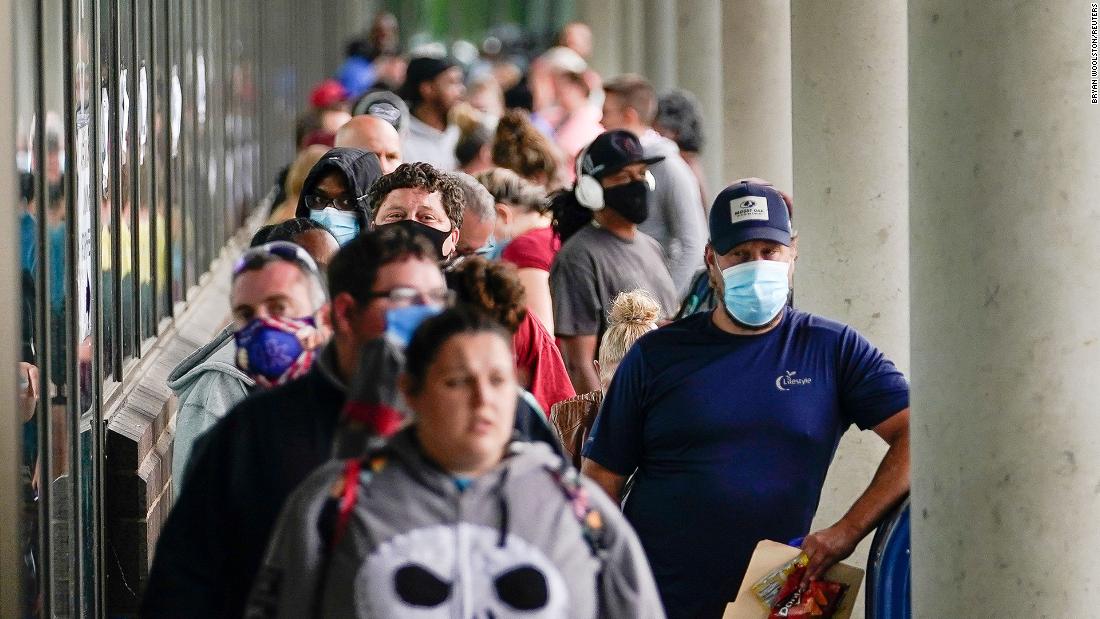This is the last week for the $600 federal lifeline for millions of unemployed Americans due to the pandemic. Here’s what you need to know.
The coronavirus relief program technically doesn’t expire until July 31, but this coming week will be the last for which benefits are paid — because payments are only provided for weeks ending on either Saturday or Sunday.
Jobless Americans will still get state unemployment benefits, but the sunset of the Congress’ $600 enhancement — part of the $2 trillion economic aid package passed in March — will leave more than 25 million people thousands of dollars poorer each month. And it will expose more of the real pain of mass unemployment, just as many states are reimposing shutdowns.
“These emergency unemployment benefits have been propping up families and propping up the economy now for several months, said Kali Grant, senior policy analyst at the Georgetown Center on Poverty & Inequality. “Ending the benefits prematurely will really set back any economic recovery that may have been on the way.”
The provision was controversial from the start, mainly because the $600 boost, when added to state benefits, is more than what two-thirds of workers made on the job, according to an estimate from University of Chicago researchers.
But lawmakers approved it in late March as part of a historic expansion of the nation’s unemployment program at a time when health officials didn’t want people out looking for work. The flat $600 payment was much easier for state agencies — which were already struggling as a flood of claims overwhelmed their antiquated technology — to implement.
Senate Republicans, who are expected to release their proposal this week, are generally loath to extend the full benefit. They feel it creates a disincentive for people to return to work, a concern echoed by some business owners. Instead, GOP lawmakers are considering scaling back the enhancement by several hundred dollars and creating a bonus for those who go back to work.
“The right thing to do for families and the economy is extend supercharged unemployment benefits,” said Oregon Sen. Ron Wyden, a Democrat. “They have unquestionably kept the economy afloat.”
Blunting the impact
The $600 payment provides more than $15 billion a week to 25 million Americans, according to an analysis by Andrew Stettner, senior fellow at The Century Foundation. Many are using it to cover their rent or mortgage, buy food and spend on other basic needs.
Shanga McNair of Jacksonville, Florida, is one of them. The veteran bartender lost her job at a brewhouse when the state shut down earlier this spring and then returned to work in early June at a jazz bar for about two shifts a week — down from her typical six. However, state officials closed the bars again in late June after coronavirus cases spiked, sending her back to unemployment. Her side jobs bartending at private parties and banquets have also dried up.


Shanga McNair, who is depending on the $600 federal unemployment payment to cover her bills, has had no luck finding another job.
The $600 federal boost, on top of her $275 weekly state benefit, is less than she made while working. It barely pays her rent but has allowed her to keep up with her bills. The 40-year-old, who also visits a local food pantry occasionally to supplement her grocery shopping, figures that if Congress doesn’t extend the enhancement, she has three months to find a job before she’s evicted.
So far, she’s had no luck. McNair has sent scores of applications to restaurants, warehouses, customer service firms and offices, but they have yielded nothing. She even filled out an application while grabbing a bite at Popeye’s after seeing the manager working multiple jobs but was told there was a hiring freeze.
“I hate depending on the government, but everything is out of my control,” said McNair, who is putting two daughters through college and has never collected unemployment before. She has written to her elected representatives in both parties. “You can’t just pull the rug because it’s not over.”
Eliminating the federal benefit will reduce workers’ weekly unemployment payments by 50% to 85%, depending on their state, Stettner said.
Also, the spike in coronavirus cases has prompted at least two dozen states to halt or reverse their reopening plans, which will also cost people their jobs. For instance, California last week ordered the shuttering of bars, movie theaters and indoor dining at restaurants statewide, as well as the closing of gyms, houses of worship, indoor malls, hair salons and some offices in many counties.
The impact is already showing up in the data. The states with the largest surge in coronavirus cases earlier this month also had the biggest increase in initial unemployment claims, according to William Rodgers III, chief economist at the Heldrich Center for Workforce Development at Rutgers University.
Some economists fear that the nascent jobs recovery will be derailed, sending even more people onto the unemployment rolls.
“Conditions in the labor market remain weak and the risk of mounting permanent job losses is high, especially if activity continues to be disrupted by repeated virus-related shutdowns,” said Rubeela Farooqi, chief US economist at High Frequency Economics.
![]()


